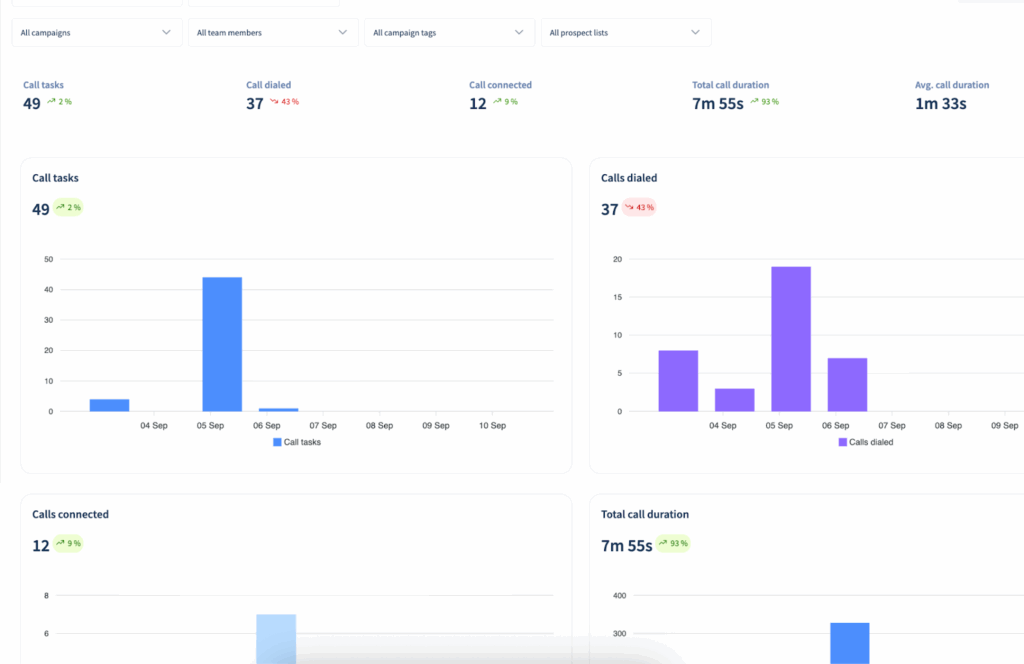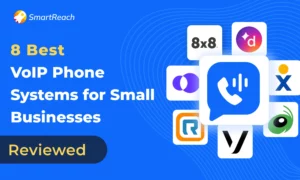How to Optimize Connect Rate & Call Script for Better Hook
Cold calling and cold emailing share one thing in common: your opening line determines conversion.
It takes structured analysis and continuous script optimization to get more prospects on the line and improve the connect rates.
In this article, you will learn how to improve call connect rates by optimizing call scripts and hooks.
Before you start the article, I will encourage you to check out the article first, “Win 1st 30 Seconds of Any Cold Call | Full Guide for Reps.” This article will answer at least 40% of your questions.
What is call connect rate?
Connect rate measures the percentage of outbound calls that reach a live human (decision-maker) not voicemail or gatekeepers.
Connect Rate = (Connected Calls / Total Calls) × 100
In B2B outbound sales, connect rates usually range between 3% and 10%, depending on your industry, data quality, and call timing.
Every small uplift in connect rate directly translates into more conversations and better sales pipeline growth.
Why does call connect rate matter so much for B2B sales?
Every outbound call costs time, effort, and resources.
And only connected calls have the potential to generate qualified opportunities.
A low connect rate means most of your team’s dialing effort never reaches a decision-maker, creating wasted activity and slower pipeline growth.
Here’s why connect rate is so critical:
- Direct impact on pipeline – Higher connect rates mean more conversations, more meetings booked, and ultimately more closed deals.
- Efficiency benchmark – If your team spends hours dialing with few connections, it’s a signal that either your data, timing, or call scripts need urgent adjustment.
- Coaching insight – Tracking connect rates by script version reveals which hooks capture attention and which ones cause hang-ups.
- Scalability – Improving connect rates by even 2–3% compounds massively across hundreds or thousands of dials each week.
Put simply, you can’t improve conversion rates without first improving connect rates.
Until you’re consistently reaching prospects, no amount of pitch refinement or objection handling will matter.
How to track & analyze call connect rate data for script optimization?
The first step toward improving your connect rate is working with clean, reliable data.
Most sales leaders focus on improving their scripts when the real problem is often data quality.
I’ve seen outbound teams achieve 40% better connect rates simply by validating phone numbers before dialing, regardless of script quality.
Without breaking down numbers in detail, it’s impossible to know whether your low connect rate comes from poor data, weak scripts, or simply bad timing.
Here’s how to approach it practically:
1. Pull data from call logs
Export call activity from your CRM or dialer. At a minimum, make sure you capture:
- Total dials made
- Connected calls (where the prospect actually picked up)
- Call duration (quick hang-ups vs. meaningful conversations)
- Outcomes (conversation, gatekeeper, voicemail, no answer)
Pro tip: If your dialer allows, tag each call with the call script version used. This will help you see which script drives higher connections.
2. Break down by key variables
Don’t just look at the overall connect rate, slice the data for deeper insights:
- Script version (A/B test) → Which opening lines got you more conversations?
- Time of day/day of week → Do prospects in your industry pick up more in mornings, afternoons, or mid-week?
- Number type → Mobile numbers usually connect more often than landlines.
- Prospect segment → C-level vs. manager-level often shows different pickup behaviors.
3. Calculate & compare connect rates
Use a simple formula:
Connect Rate (%) = (Connected Calls ÷ Total Dials) × 100
Example:
- Script A: 500 dials → 40 connections → 8% connect rate
- Script B: 500 dials → 75 connections → 15% connect rate
This data shows Script B is almost 2x more effective in securing conversations.
4. Look for patterns in the calling performance
Data becomes actionable when you spot trends. Ask:
- Do certain scripts consistently get longer conversations?
- Do some openers trigger immediate hang-ups?
- Does timing change connect success for a specific industry?
This level of breakdown helps you move beyond guesswork and identify what truly makes prospects engage.
How to compare calling script variants for performance?
Once you’ve tracked your connect rate data, the next step is figuring out which scripts actually work.
Here’s how to do a systematic comparison of script variants is critical.
1. Run A/B tests with clear variations
Don’t test scripts that differ in 10 ways, you won’t know what caused the change.
Instead, adjust only one variable at a time, such as:
- The opening line (e.g., “Did I catch you at a bad time?” vs. “The reason I’m calling is…”)
- The value hook (pain-focused vs. outcome-focused)
- The tonality or pacing (formal vs. casual opener)
Keep both versions running in parallel for at least 200–300 dials each to get statistically valid results.
2. Track engagement beyond connects
A script with a high connect rate isn’t always the best if people drop off within seconds. Measure:
- Average call duration → Longer conversations suggest interest.
- Positive outcomes → Meetings booked, callbacks scheduled, or “send me an email.”
- Drop-off rate → Calls under 15 seconds often signal a weak hook.
3. Score and rank script performance
Create a simple scoring system that balances connect rate with engagement quality. Example:

Even if Script B has only a slightly higher connect rate, the longer conversations and meeting outcomes prove it’s a better hook.
4. Involve the sales team in feedback loops
Numbers alone can’t tell you everything.
SDRs and BDRs know when a script “feels natural” versus when it feels forced.
Hold short weekly reviews to:
- Share which openers feel most comfortable.
- Highlight common objections triggered by each script.
- Adjust wording based on both data and field experience.
This dual feedback system ensures you’re not just optimizing for connects, but also for conversion potential.
3 Types of best practices to improve call connect rates
Here are some additional best practices that you can follow for improving your call connect rates –
#1. Prioritize number quality
- Rotate numbers to avoid spam flags.
- Use branded caller IDs when possible.
- Validate and clean your prospect lists before dialing.
#2. Keep calling scripts conversational
- Provide reps with talking points instead of rigid scripts.
- Encourage natural pauses and questions.
- Personalize with industry or role-specific insights.
#3. Real-time coaching and monitoring
- Review call recordings to spot drop-off moments.
- Coach SDRs on tone, pacing, and objection handling.
- Use analytics tools to identify which parts of a script lose prospect interest.
Also read: Cold Calling Guide
How SmartReach.io helps you run calling campaigns 2x more efficiently
SmartReach.io’s PowerCaller is built to help sales teams get more prospects on the line and improve the quality of those first few seconds that decide a call.
Instead of using separate tools for calling and testing scripts, you can get them together inside a single platform.
Here’s how –
1. Call scripts built into campaigns

You can add calling scripts directly inside campaigns so every rep stays consistent while still leaving room for personalization.
2. Power dialer for faster connects
The auto-dialer moves reps through call lists quickly, cutting out wasted time between dials.
More calls made = more chances to test different scripts and gather data on what works.
3. Local Caller IDs that get pickups
Prospects are more likely to answer if the number looks familiar.

SmartReach.io lets you use local presence caller IDs, which increases answer rates and gives your hooks more room to work.
4. Call recording & sentiment tracking
Every call can be recorded and tagged with outcomes like positive, neutral, or negative.

This makes it easy to spot patterns like which script versions trigger longer conversations or which openers shut down calls too quickly.
5. Live coaching during calls
Managers can listen in, whisper guidance, or even join the call if needed.

It’s a powerful way to adjust scripts in real time and coach reps without waiting for a post-call review.
6. Automatic Reports & CRM Sync
All call data including connect rates, talk time, outcomes syncs with your CRM automatically.

*SmartReach.io calling report dashboard
Reports show you which scripts are driving higher connects, making it easier to roll out changes across the team.
With these features, SmartReach.io helps you make better calls that consistently improve connect rates.
F.A.Qs
Q: What’s a good connect rate for B2B cold calls?
A: Typical connect rates range from 3% to 10%, though top-performing teams may exceed this with optimized scripts and clean data.
Q: How do I know if my call script is effective?
A: Track connect rates and conversation length for each script version. Scripts that keep prospects on the line longer are usually the most effective.
Q: How often should call scripts be updated?
A: Treat scripts as living documents. Update them regularly based on connect rate data, prospect feedback, and SDR performance reviews.
Q: What factors influence connect rates the most?
A: The biggest factors are call timing, caller ID familiarity, data accuracy, and the strength of your opening script. Even small changes in these areas can shift results.
Q: Should I personalize call scripts for different buyer personas?
A: Yes. Tailor your opening lines to the prospect’s role and industry. A CFO may respond to cost-saving hooks, while a Marketing Head may engage with growth-driven outcomes.
Q: How many script versions should I test at once?
A: Limit tests to two versions (A/B test) at a time. This helps isolate which specific change impacts connect rates without adding confusion.
Q: Can technology improve my connect rate?
A: Absolutely. Tools like power dialers, local presence caller IDs, and call sentiment analysis increase pickup likelihood and help you refine scripts faster.
“`html “`


